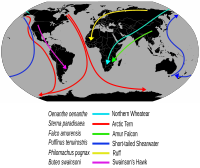
Photo from wikipedia
The development and miniaturization of GPS tracking devices has enabled a better understanding of migration phenology, but it can be challenging to identify where and when migration starts and ends,… Click to show full abstract
The development and miniaturization of GPS tracking devices has enabled a better understanding of migration phenology, but it can be challenging to identify where and when migration starts and ends, and researchers rely on multiple methods to infer it. Here, we use GPS tracks of 18 trans‐Saharan migrant White Storks Ciconia ciconia to determine how the choice of method influences the estimation of migratory timing and discuss its implications. We evaluate and provide R code for the implementation of five alternative methods: spatial threshold, absolute displacement, spatio‐temporal displacement, net squared displacement and change point analysis. Spatial threshold, absolute displacement and spatio‐temporal displacement methods produce, in most cases, significantly different estimates of migration timing and duration as compared with net squared displacement and change point analysis.
Journal Title: Ibis
Year Published: 2020
Link to full text (if available)
Share on Social Media: Sign Up to like & get
recommendations!